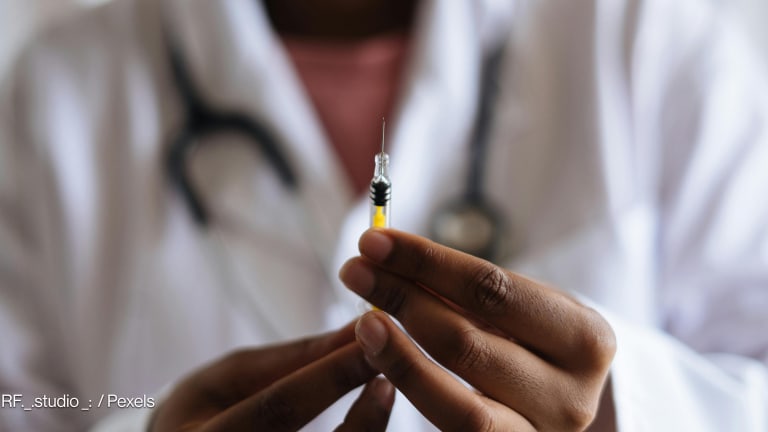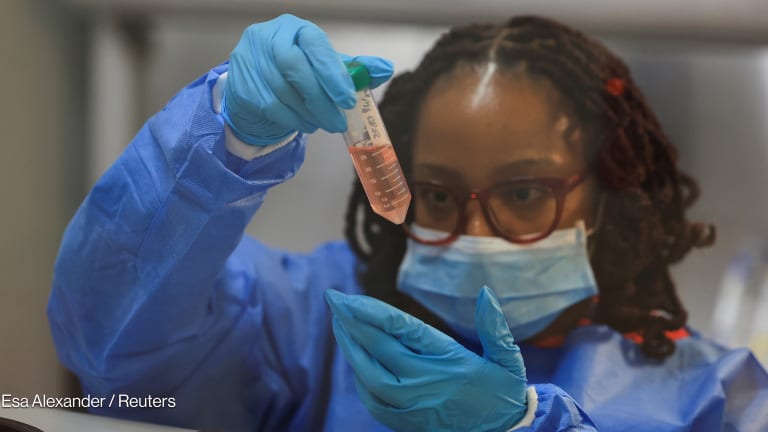
ALEXANDRA, South Africa — When Thapelo — name changed to protect his identity — went to government clinics to collect medicine for chronic blood pressure, the lines were so long that he was often forced to take the day off work. And at times, he’d even leave without his medication.
“The line is very long and then they say, ‘you may come tomorrow,’” said the 58-year-old, “it affected my health.”
South Africa needs about 12,000 pharmacists to fulfill the international standard of 50 pharmacists per 100,000 people, according to a report published in 2017 by the country’s department of trade and industry.
Why training pharmaceutical regulatory professionals is key to improving health in Africa
In a quiet corner of Accra, Ghana, one training center is taking on substandard and falsified medicines and, with it, the region’s health outcomes. Reporting from Ghana, Devex investigates.
According to the South African Pharmacy Council, the patient-to-pharmacist ratio is 3,389 persons per pharmacist: About 30 pharmacists per 100,000 people. The South African government has struggled to attract the necessary numbers, with government clinics paying little money, and pharmacists often attracted by better opportunities abroad.
The result is that some 68 percent of patients spend between two to five hours waiting for a consultation with a doctor, depending on the facility, stated another 2014 government report.
But these days, Thapelo collects his medicine from an “ATM pharmacy.” ATM in appearance, these machines accurately dispense vital repeat medication for chronic stable patients who have HIV/AIDS, diabetes, high blood pressure, asthma, epilepsy, or tuberculosis — in just under three minutes.
Apart from cutting down on patient wait times and lessening the likelihood that patients will fail to pick up their medication altogether, it frees pharmacists to focus on counseling about the appropriate and safe use of medicine, side-effect aversion, lifestyle modification, increase medication adherence, and prevent diseases.
So far 16 pharmacy dispensing units have been installed near shopping malls in Alexandra, Soweto, and Diepsloot townships in Johannesburg, and have served thousands of patients between March and the end of May. During that time, medication was picked up 19,352 times.
The 2 million rand ($150,000) machines are the first of their kind and were eight years in the making. The brainchild of non-profit organization Right to Care, one of South Africa’s biggest NGOs, and solution provider Right ePharmacy, which worked with the Department of Health of Gauteng province and the banking sector on the initiative. USAID and GIZ are also supporting the project.
The ATMs boast cloud-based electronic software and robotic technology to dispense and label medication, and have a 24-hour operating capability. A user-friendly interface and an information touch screen available in 11 languages allows a two-way audio-visual conversation between a patient and a qualified “tele-pharmacist” at Right ePharmacy’s Pretoria headquarters.

Patients with chronic medication that have been classified as clinically stable and showing responsible health behavior by nearby clinics, are referred to the ATM pharmacies. The ATMs are open Monday to Friday from 7 a.m. to 6 p.m., and weekends and public holidays from 9 a.m. to 2 p.m.
In five easy steps — using a barcode ID book, ID card, or pharmacy card, and a PIN code — patients can collect their medicines, robotically dispensed on-site, from the machine’s shoot, and be given counseling if necessary. It’s “personal, face-to-face interaction, communication and counseling with the patient”, said Right ePharmacy.
Their receipt shows their next collection date, with collection reminders sent via SMS, and late collections are also followed up via phone.
“To collect the medication to me it’s very easy,” said Thapelo, who lives nearby Alex Plaza. It was chosen as flagship pharmacy dispensing unit location as the mall in the high-density township is central and close to public transport.
“It’s easy, I can walk,” said the maintenance worker about the machines, husband, and father of four, who had popped in to collect his medicine after work.
Thapelo said that he could also leave his job quickly to pick up his medicine “and you won’t be fighting with your bosses”.
“If I find a queue, there’s only two or three people,” he said. “It takes not more than 10 minutes. So simple. I’m happy to come here.”
“Before, I was working in a government hospital, we would see queues,” said Alex Plaza pharmacy dispensing unit site manager, Taffy Chinamhora. “People’s [health] deteriorates. People are forced to take a leave day, so it’s lost time, lost income.”
Although the ATMs are focused on treating a number of chronic conditions, Chinamhora estimated that about 70 percent of patients were collecting antiretroviral therapies. South Africa has the biggest HIV epidemic, and the highest rollout of antiretroviral therapy or ARVs in the world, according to UNAIDS.
The shortest dispense time since operations began has been one minute and 20 seconds, with the longest six minutes, according to Right ePharmacy.
“The ATM-like approach to dispensing medication demonstrates how innovative new approaches can overcome existing health system challenges — and support people to get on, and stay on HIV treatment, and ultimately save lives.”
— Timothy Mah, acting health office director for USAID’s Southern Africa regional programSouth Africa’s Central Chronic Medicines Dispensing and Distribution program, which has been rolled out since 2014, has assisted 1.8 million patients and has “reduced waiting times significantly,” Foster Mohale, national health ministry spokesman, told Devex.
But he added, “South Africa does have a shortage of pharmacists so we welcome the ATM innovation.”
Timothy Mah, acting health office director for USAID’s Southern Africa regional program, told Devex the pharmacy dispensing units were an “exciting and innovative solution that uses technology to move beyond traditional healthcare delivery.”
“The ATM-like approach to dispensing medication demonstrates how innovative new approaches can overcome existing health system challenges — and support people to get on, and stay on HIV treatment, and ultimately save lives,” he said.
Daniela Rudner, senior manager at GIZ South Africa, said the pharmacy dispensing units were an “an innovative response to the challenge of drug distribution in South Africa’s public health system, which is overwhelmed by patient volumes.”
“Instead of queuing up in overflowing waiting rooms, patients requiring chronic medication can now receive their medication faster, easier, and at the time and location they prefer,” she told Devex.
In neighboring Zambia, Right ePharmacy is launching a centralized dispensing unit, which enables decanting of stable chronic patients, in a bid to reduce congestion at health centers. Pharmacists and pharmacy assistants in a high-volume dispensing and distribution unit receive, validate, and capture prescriptions to create an electronic record. They then label a multi-month supply of medication for delivery to a collection point of a patient’s choice. The project began in mid-June.
Fanie Hendriksz, Right ePharmacy managing director told Devex: “because of the uniqueness of the innovation,” the ATM pharmacies had “the potential to make a massive impact.” For the same number of pharmaceutical staff as a conventional clinic, you can serve 35 to 45 percent more patients.
Hendriksz said when he became a pharmacist 19 years ago, this sort of technology was “a pipedream.”
“The way that the industry everywhere in the world fights [patient challenges] in public health [is to] either build more facilities or put more people [in],” he said.
“But it’s not solving the problem. So the need for a differentiated model of care became more and more obvious. What we’re seeing with the ATMs is, there’s very unique methods of scaling up access to care.”
Devex, with financial support from our partner MSD for Mothers, is exploring how the private sector is driving innovations in global health. Visit the Focus on: Future of Health Partnerships page for more.




